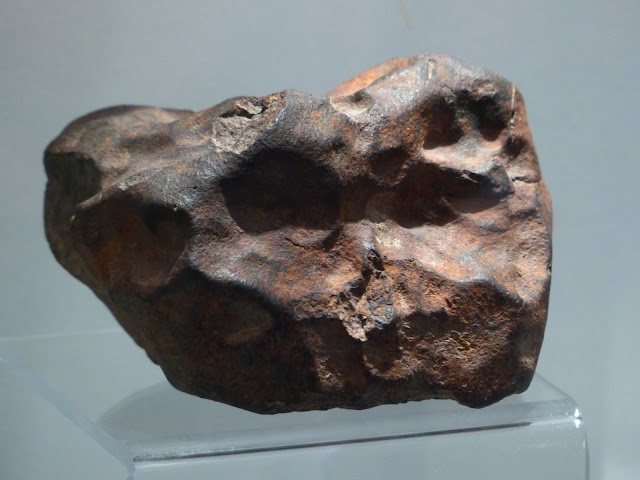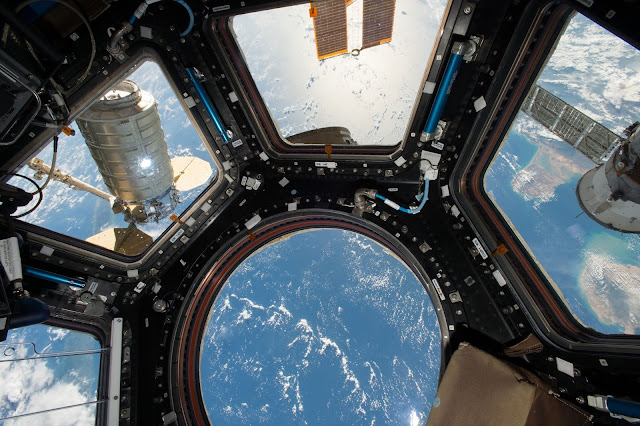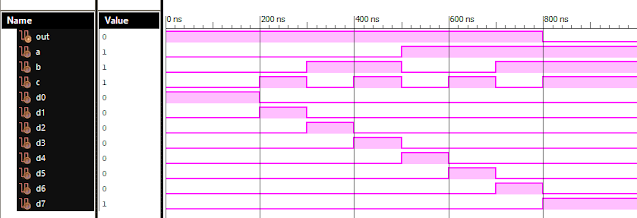Posts
Showing posts from January, 2020
Latest Post
Alien Stones from Space !!
- Get link
- X
- Other Apps

Many people have some unique interesting hobbies, one of that is collection of heavenly stones (Meteorite Stones). We can also find a museum at Chicago called "Garden of Heaven". Garden of Heaven is museum of meteor stones collected from different places and different continents. For some this is business, to hunt for meteor stones and sell at very high price. So where do these 'Heavenly Rocks' come from? Meteorite Stone Most of the meteors belong to Asteroid belt between orbits of Mars and Jupiter, but few of them belonged to Moon and Mars!! Sometimes when a massive Asteroid hits surface of Mars, small surface objects on mars bounces and leaves gravity of Mars. When such objects are captured by Earth's gravity, they enter into Earth's atmosphere. Similarly different objects arrive from Moon. This is possible because Mars has weak gravity and moon being closest to Earth with very weak gravity. Mechanic Farmer is a well known name of Meteor...
International Space Station: A Space Tour
- Get link
- X
- Other Apps

ISS or International Space Station is a space-station orbiting Earth 400 Km above the sea level with speed 27000 Km/hr. It is a joint project of countries like USA, Russia, Japan, ESA and CSA. ISS completes one revolution around Earth in just 93 minutes. That means in 24 hours it takes 15 revolutions. Weight: 400 tons Breath: 109 m Length: 73 m ISS is divided in 2 parts, American Orbital Segment (USOS) and Russian Orbital Segment (ROS). Let's take a look at different modules of ISS: 1. Destiny: Destiny module is built by NASA. It is used for experiments and taking photos from 151 cm window. 2. Quest: Quest module is constructed by NASA. Quest contains Airlock system, and is used for spacewalks. Quest also houses spacewalk devices and spacesuits, also used as resting place for Astronauts. 3. Peer and Poshk: It ia a Russian docking module. This module contains 2 docking facility and auto fuel transfer facility. Soyuz and Progr...
Planets: Jupiter
- Get link
- X
- Other Apps

A look at some interesting facts of Jupiter: Jupiter and Spacecraft Juno, Artist Image Jupiter is the largest planet of our solar system, so big that it can fit more than 1300 Earths inside it. Thick colorful clouds of deadly poisonous gases surround Jupiter. The quick spinning of the planet whips up the atmosphere, creating bands around the planet. If you were to descend into Jupiter, thin cold atmosphere becomes thicker and hotter, gradually turning into a thick dark fog. In the blackness about 1000 Km down the pressure squeezes the atmosphere so hard that it turns into liquid. Center of Jupiter is made up of rocky core, slightly bigger than Earth but weighing about 20 times more than weight of Earth. Surrounding the core is ocean of liquid hydrogen, about 1000 Km deep. Jupiter has many storms, some can be seen from Earth via telescope. The big red spot of Jupiter is the largest hurricane in our solar system. It's been ranging for 3 hundred year...
Space Facts: Part 9 - Quantum Fluctuations
- Get link
- X
- Other Apps
Have you heard of Quantum Fluctuations? It's a part of Quantum Physics. Quantum Fluctuations describe that even from void space matter can be generated. But for this to happen there are certain rules: 1. Matter appearing from void will have negligible mass. 2. Matter will appear for very less time and disappear again. 3. Heavy mass matter cannot be generated. Now, assume that in empty space there is no form of positive energy, but energy is present in negative form. From this negative energy particles may be formed for very less amount of time and gives back energy to surrounding and disappears. By Quantum Fluctuations particles like electrons can be created but not protons and neutrons. Einstein compared this principle with universe and gave his theory of Relativity. How we find the age of Universe practically? BICEP 1 and BICEP 2 are gravity wave telescopes located in Antarctica. BICEP 2 captured 13.7 billion years old gravity waves, which were the oldes...
Space Facts: Part 8 - Birth of Universe, Cosmic Inflation
- Get link
- X
- Other Apps
The Birth of Universe: It is believed that before Big bang universe was a tiny point having infinite density and infinite temperature. Surrounding of that point was void, having no matter, no temperature and no time. After Big-Bang (a great explosion from that singular point) the 'matter' spread in all directions at the speed of light. According to theory of relativity, if an object travels at a speed of light, time dimension for that object becomes zero. In other words time stops for that object. So within no time that minute zero dimensional point became an expanding universe. This expansion of Universe after Big-Bang is called Cosmic Inflation. Now what is Cosmic Inflation Theory? Cosmos means Universe and Inflation refers to Spread of Universe. Big-Bang theory does not explain from where that point universe came into existence and what happened after Big-Bang. Cosmic Inflation Theory explains what happened after Big-Bang. Cosmic Inflation Theory starts when ...
Space Facts: Part 7 - Mysterious Sun, Multiverse, Dark Matter
- Get link
- X
- Other Apps
Mysterious Sun: Even though we know Sun from centuries, there are many mysteries of Sun remained unsolved. Most popular mystery is regarding Corona of Sun. Corona is outer layer of Sun's atmosphere. Corona is hotter than the inner layer Chromosphere. Sun's visible surface Photosphere has temperature 5800°C. Outer layer of Photosphere is Chromosphere. Temperature of Chromosphere is estimated to be 4000°C. But astonishing fact is that Corona (outermost layer of Sun) is 3 million ℃. This is not possible if Heat Transfer laws are to be considered. To study about Sun in detail NASA sent a probe in 2018, ISRO will send Aaditya L1 probe to Langlargian L1 point from where Aaditya L1 will study the properties of Sun. Are there Multiple Universes? Multiverse theory is Hypothetical theory giving arguments of multiple universe are present in space-time. Many different Multiverse theory are formed. According to one, different universe may have different laws ...
Space Facts: Part 6 - Apogee and Perigee
- Get link
- X
- Other Apps
What is Apogee and Perigee ? The point of orbit nearest to Earth is Perigee and farthest from Earth is called Apogee. Satellites sent from PSLV rockets follow this system as the speed of PSLV rockets is less than 11.2 Km/sec. Here spacecrafts have to change different orbits (also known as Orbit Maneuvers) around Earth to get speed of 11.2 Km/sec. By achieving speed higher than 11.2 Km/sec we spacecrafts can escape Earth's gravity, this velocity is called "Escape Velocity". GSLV MK III rockets have speed 11.2 Km/sec, so spacecrafts do not have to change different orbits and spacecrafts are directly inserted into space. Mangalyaan had to undergo Orbital Maneuvers as it was launched from PSLV rocket. If it was to launch from GSLV MK III, Mangalyaan would take less time to reach Mars than it took with PSLV. In Apogee and Perigee the orbit is of elliptical shape. When spacecraft travels from Apogee to Perigee it gains velocity die to gravity of Earth. Orbit o...
Space Facts: Part 5 - Amazing Moons, Ultra Dark Galaxies, Moon quakes
- Get link
- X
- Other Apps
1. Amazing Moons: Ganymede, Europa and Callisto are moons of Jupiter where it is believed that these moons contain Frozen Water. Enceladeus moon of Saturn is believed to have Hot Water springs on its surface due to very high surface temperature of moon. 2. Ultra Dark Galaxy: 800 ultra dark galaxies are found in Coma Cluster of Galaxies. Coma Cluster contains only 1/1000 times the stars than that of our galaxy. The component visible matter, such as stars is only 1% of total mass of each galaxy, the rest mass is made up of Dark Matter. Blackhole of 140 Million times the mass of Sun is discovered in NGC 1097 Galaxy. 3. What are Moon-quakes ? By studying the scientific data from Chandrayaan 1 mission of ISRO, scientists belive that the crust of moon is also made up of plates just like Earth. Earlier NASA scientists believed that Moon-quakes were caused by rocks beneath the surface of moon. The temperature difference of day and night of Moon is very h...
Space Facts: Part 4 - Celestial Dust, Kepler 289
- Get link
- X
- Other Apps
1. What is Celestial Dust: Cluster of galaxy: Abell 1698 , A1698-ZD1 galaxy in galaxy cluster of Abel 1698 is full of space dust. Dust is made up of Silicon, Iron, Oxygen, Magnesium, Carbon, etc. Elements and dust are formed in stars by nuclear processes from gases like Helium and Hydrogen. When star dies dust and gases are emitted. So dust was formed only after bigbang happened. 2. Kepler 289 Star: PH3c (Kepler 289c) is a dwarf planet discovered in solar system of PH3 star. PH3c planet has irregular revolution time due to external gravitational force from other planets affecting the planet's revolution. Other planets of that solar-system are PH3b (Kepler 289b) and PH3d (Kelper 289d). PH3b and PH3d planets are very massive in size as compared to PHc so they pull the planets towards themselves when PH3 passes near them, changing the revolution orbit of PH3c. Astronomers estimate that after millions of years PH3c will be removed outside solar system by gravity-pul...
Space Facts: Part 3 - Cheapest Interplanatery Mission, Comets, Magnetic Field, Different types of Stars
- Get link
- X
- Other Apps
Cheapest Interplanetary Spacecraft: Mangalyaan Mangalyaan mission cost was 450 Crore Rupees. Rocket: PSLV-C25 Organization: ISRO Mangalyaan spacecraft 150 Crore. Rocket Cost: PSLV-C25: 110 Crore. Weight of Mangalyaan: 1350 Kg, out of 1350 Kg, 500 Kg is weignt of spacecraft and rest is fuel weight. Mangalyaan is also called Mars Orbiter Mission (MOM), Travelled for 25 days around earth changing 6 orbits, and 326 days between Earth and Mars. Comets: Kuiper Belt and Cloud of Urt are home to most of the comets of our solar-sysem. Some well known comets are: 1. Comet Siding Spring: Took a fly-by near Mars on October 19, 2014. 2. Great Comet of 1980 was the first Comet Registered. 3. Haley's Comet: Passes near Earth every 75 years. 4. Comet Shoemaker Levy 9, a comet that ended up clashing with giant Jupiter! It's the first collision ever recorded by any celestial body in our solar system. When this comet was passing nearby Jupiter due to high gravity of plan...
Space Facts: Part 2 - Dark Matter, Comet 67P and Different types of Space Telescopes
- Get link
- X
- Other Apps
1. Dark Matter: Dark matter is made up of WIMP or AXION particles, WIMP means Weakly Intensive Massive Particles. 2. Comet: 67 P 67P/Churyumov Gerasimenkov comet takes 6.5 earth years to complete one revolution of solar system. Rosetta is the first satellite to reach comet's orbit. Rosetta is spacecraft from ESA (European Space Agency) which contained Rover and Orbiter. Comets generally come from Cloud of Urt or Kuiper Belt. 3. Space Telescopes and Observatories: There are different types of space observatories made by different space organizations like NASA, ESA, JAXA, ROSCOSMO, CNSA, ISRO, etc. X-Ray: Chandra X-Ray Spacecraft Gravity wave telescope: BICEP 2 Microwave: Wisconsin Microwave Aniastropy Probe, Cosmic Microwave Background Explorer (COBE) Gamma Ray,Neutrino observatory, Optical telescope, etc.
Space Facts: Part 1 - Goldilock Zone, Exoplanets, Brown Dwarf and Dwarf Planets
- Get link
- X
- Other Apps
Welcome to Stellar Space Stellar Space blog is made to distribute the unknown knowledge regarding space science which we normally don't find in books and also not in any movies. this blog contains many details regarding Planets, stars, Exoplanets, Cosmic voids, Dark matter, Gravitational waves, Cosmology, Space horizons and many more things. Let's start with Space Fact series... Space Facts: Part 1 1. What is Goldilock Zone: Goldilock zone is also called Habitable Zone. it is the zone in which humans can survive. Earth is situated in Goldilock zone of our solar system. Many other solar systems too have Goldilock Zone. For example Kepler 186F planet is also situated in Goldilock zone of a distant solar system. Space Scientists usually try to find such planets because these planets have maximum possibility of holding life. 2. Exoplanets: Exoplanets are planets which do not reside in any of the solar system and freely wander in universe, certain planets a...
Popular posts from this blog
Verilog: 8 to 1 Multiplexer (8-1 MUX) Dataflow Modelling with Testbench Code
Verilog Code for 8 to 1 Multiplexer Dataflow Modelling module mux_8to1( input a, input b, input c, input D0, input D1, input D2, input D3, input D4, input D5, input D6, input D7, output out, ); module m81( output out, input D0, D1, D2, D3, D4, D5, D6, D7, S0, S1, S2); assign S1bar=~S1; assign S0bar=~S0; assign S2bar=~S2; assign out = (D0 & S2bar & S1bar & S0bar) | (D1 & S2bar & S1bar & S0) | (D2 & S2bar & S1 & S0bar) + (D3 & S2bar & S1 & S0) + (D4 & S2 & S1bar & S0bar) + (D5 & S2 & S1bar & S0) + (D6 & S2 & S1 & S0bar) + (D7 & S2 & S1 & S0); endmodule //Testbench code for 8-1 MUX Dataflow Modelling initial begin // Initialize Inputs a= 0;b = 0;c = 0;D0 = 1;D1 = 0;D2 = 0;D3 = 0;D4 = 0;D5 = 0;D6 = 0;D7 = 0; // Wait 100 ns for global reset to finish #100; // Add stimulus here #100; a = 0;b = 0;c = 1;d0 = ...
VLSI: 8-3 Encoder Dataflow Modelling with Testbench
Verilog Code for 8-3 Encoder Dataflow Modelling module encoder_8_to_3( input d0, input d1, input d2, input d3, input d4, input d5, input d6, input d7, output q0, output q1, output q2 ); assign q0 = ( d1 | d3 | d5 | d7 ); assign q1 = ( d2 | d3 | d6 | d7 ); assign q2 = ( d4 | d6 | d5 | d7 ); endmodule //Testbench code for 8-3 Encoder Dataflow Modelling initial begin ...
VLSI: 4-1 MUX Dataflow Modelling with Testbench
Verilog Code for 4-1 MUX Dataflow Modelling module m41(out, i0, i1, i2, i3, s0, s1); output out; input i0, i1, i2, i3, s0, s1; assign y0 = (i0 & (~s0) & (~s1)); assign y1 = (i1 & (~s0) & s1); assign y2 = (i2 & s0 & (~s1)); assign y3 = (i3 & s0 & s1); assign out = (y0 | y1 | y2 | y3); endmodule //Testbench code for 4-1 MUX Dataflow Modelling initial begin // Initialize Inputs a = 1;b = 0;c = 0;d = 0;s0 = 0;s1 = 0; ...
Full Subtractor Verilog Code in Structural/Gate Level Modelling with Testbench
Verilog Code for Full Subtractor Structural/Gate Level Modelling module full_sub(borrow,diff,a,b,c); output borrow,diff; input a,b,c; wire w1,w4,w5,w6; xor (diff,a,b,c); not n1(w1,a); and a1(w4,w1,b); and a2(w5,w1,c); and a3(w6,b,c); or o1(borrow,w4,w5,w6); endmodule //Testbench code for Full Subtractor Structural/Gate Level Modelling initial begin // Initialize Inputs a = 0; b = 0; c = 0; // Wait 100 ns for global reset to finish #100; // Add stimulus here #100; a = 0;b = 0;c = 1; #100; a = 0;b = 1;c = 0; #100; a = 0;b = 1;c = 1; #100; a = 1;b = 0;c = 0; #100; a = 1;b = 0;c = 1; #100; a = 1;b = 1;c = 0; #100; a = 1;b = 1;c = 1; end Output: RTL Schematic: Full Subtractor Verilog Other Verilog Programs: Go to Index of Verilog Programming
VLSI: 1-4 DEMUX (Demultiplexer) Dataflow Modelling with Testbench
Verilog Code for 1-4 DEMUX Dataflow Modelling module demux_1_to_4( input d, input s0, input s1, output y0, output y1, output y2, output y3 ); assign s1n = ~ s1; assign s0n = ~ s0; assign y0 = d& s0n & s1n; assign y1 = d & s0 & s1n; assign y2 = d & s0n & s1; assign y3 = d & s0 & s1; endmodule //Testbench code for 1-4 DEMUX Dataflow Modelling initial begin // Initialize Inputs ...




